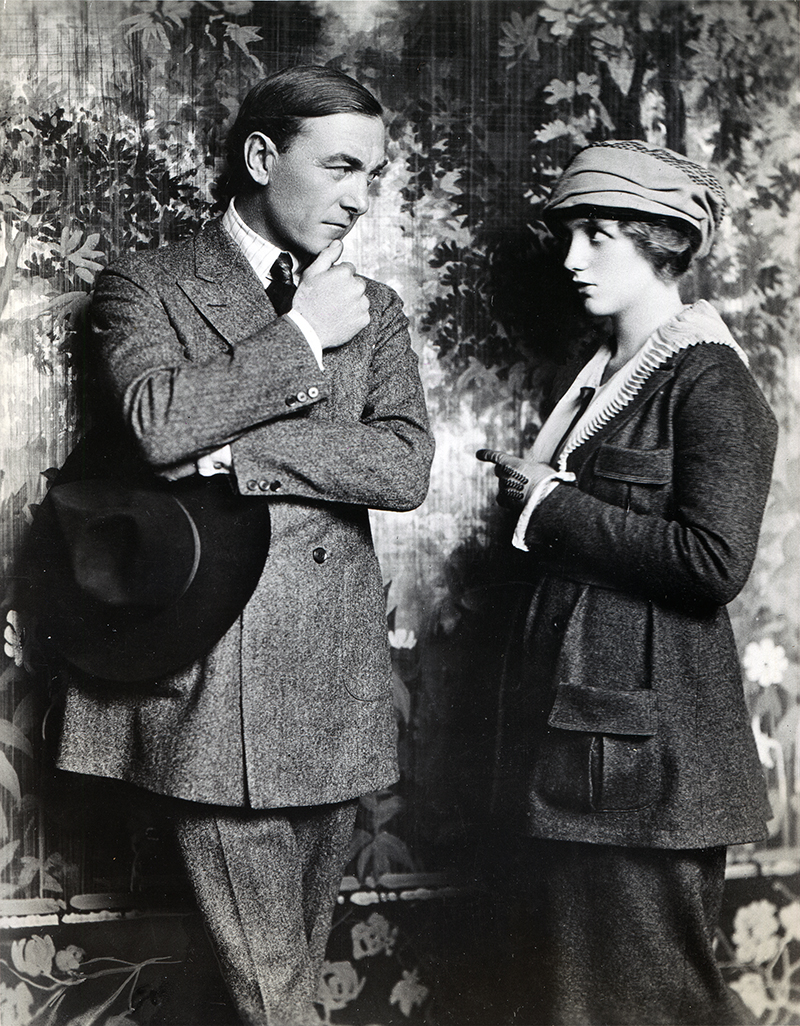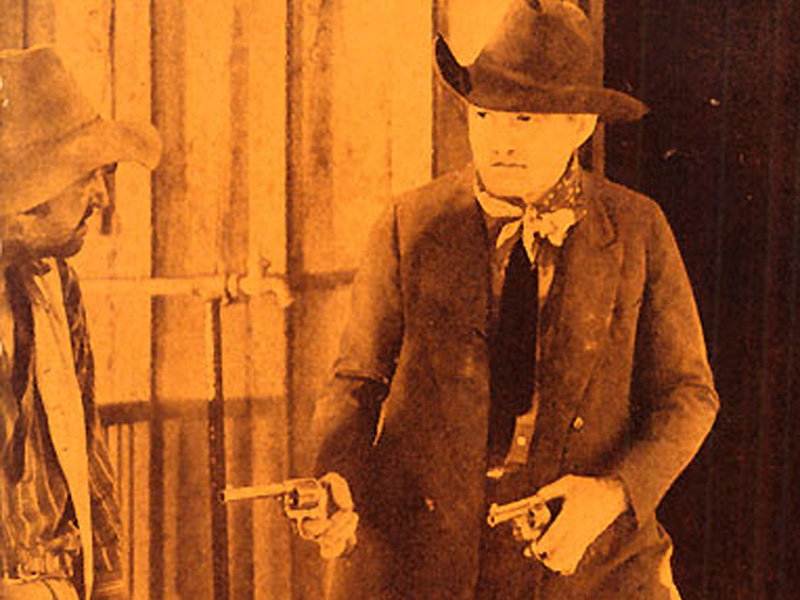|
|
Actors and Saugus Residents

Click image to enlarge
Actors and Saugus residents Harry and Olive Carey in 1919. ACME wire photo, 7x9 inches, from an unidentified newspaper archive. Original cutline written in 1941 reads:
MR. AND MRS. There are a couple of problems with that caption. It's true that Harry Carey and his manager (agent), Olive Fuller Golden, were living as husband and wife at their San Francisquito Canyon ranch in 1919, but they weren't legally married. Harry's divorce from his second wife, Fern Foster (whom he married in 1916 when he bought the ranch), was not final until Jan. 2, 1920. Harry remarried Olive "for real" in San Francisco in March 1921. (Click here to read about Harry's marriages.) Also, in 1919, Olive wasn't "then his leading lady on the screen." In 1916 she took a 15-year hiatus from acting; she devoted her time to managing Harry, and then to raising his two children — Harry Jr. (Dobe), born in 1921, and Ella (Cappy), born in 1923. Olive returned to the screen in 1931 when she accompanied Harry to Africa to make "Trader Horn" with Edwina Booth and Duncan Renaldo. Dobe Carey, who would appear in nine of John Ford's pictures, gives some family background and credits his parents with giving the famous director his start (Harry Carey Jr. 1996:45): My mother was a young actress of sixteen at Universal Studio at the same time Jack Ford was working there as a combination propman-stuntman for his brother Francis Ford, who was a major star there. Her father, George Fuller Golden (christened George Michael Fuller), had been a famous monologist in vaudeville. He, George M. Cohan, and Jim Corbett were the founders of the first actors' union for stage performers, the White Rats of America. All of us Careys are very proud of that. Olive Fuller (Golden was added by her father as part of his stage name) was born on January 31, 1896, and John Ford was born on February 1, 1894. Pop [Harry Carey Sr.] was pushing forty before Mom and John Ford were able to vote. All the young people at the studio hung out together, so it was my mom who first introduced John Ford to Harry Carey. Pop was responsible for Ford being a director. He convinced the head of Universal, Carl Laemmle, to let Jack direct his next movie, which he did, but they both took a cut in salary. The two of them would pack up camera, cast, and crew and make silent movies in the desert wastes of Southern California. They [Harry Sr. and John Ford] were a fantastic pair until they split up in 1921.
About Harry Carey Sr. Actor Harry Carey (Sr.) acquired a homestead at the mouth of San Francisquito Canyon in 1916 and established a rancho. The ranch included the Carey's wooden ranch home as well as several outbuildings and the Harry Carey Trading Post, which was a tourist attraction that included billed entertainment from Navajo Indians and other performers, along with a store that sold Western and Indian curios. The ranch was occasionally used for filming. The Careys' son, Harry Carey Jr. (Dobe), who would follow in his father's acting footsteps, was born in the Carey ranch home in 1921. The trading post washed away in the St. Francis Dam disaster of March 1928 and was not rebuilt. The Indians left about a month earlier, son Dobe said in a 2005 interview. Dobe said a shaman saw "a big crack and predicted it would break." The ranch house was situated at a higher elevation and survived the flood, only to burn down in 1932. The Careys replaced it by building a Spanish adobe home, which they sold with the rancho in 1945. Harry Carey was born Henry DeWitt Carey II on January 16, 1878 on 116th Street in the Bronx section of New York City. His father was a special-sessions judge and president of a sewing machine company. Harry attended a military academy but declined an appointment to West Point, instead trying his hand as a playwright. According to the Internet Movie Database: In 1911, his friend Henry B. Walthall introduced him to director D.W. Griffith, for whom Carey was to make many films. Carey married twice [correx: 3 times; see here], the [third] time to actress Olive Fuller Golden (aka Olive Carey), who introduced him to future director John Ford. Carey influenced Universal Studios head Carl Laemmle to use Ford as a director, and a partnership was born that lasted until a rift in the friendship in 1921. During this time, Carey grew into one of the most popular Western stars of the early motion picture, occasionally writing and directing films as well. In the 1930s he moved slowly into character roles and was nominated for an Oscar for one of them, the president of the Senate in "Mr. Smith Goes to Washington" (1939). He worked once more with Ford, in "The Prisoner of Shark Island" (1936), and appeared once with his son, Harry Carey Jr., in Howard Hawks' "Red River" (1948). He died Sept. 21, 1947, in Brentwood, after a protracted bout with emphysema and cancer. Ford dedicated his remake "3 Godfathers" (1948) "To Harry Carey — Bright Star Of The Early Western Sky." Carey would appear in at least 233 films, including short features, between 1909 and 1949. Further reading: Harry Carey Ranch: Historic American Buildings Survey No. CA-2712.
LW2791a: 9600 dpi jpeg from original photograph purchased 2015 by Leon Worden. |
FULL MOVIE:
Broken Ways 1913
FULL MOVIE 1938
Fan Reply Card <1928
Marriages
Marked Men 1919
A Fight for Love 1919
Harry & Olive 1919
Overland Red 1920
Canyon of the Fools 1923
The Seventh Bandit 1926 (Mult.)
Satan Town 1926
Burning Bridges 1928
Trader Horn 1931
The Vanishing Legion 1931 (Mult.)
The Devil Horse 1932
Rustler's Paradise 1935
Last of the Clintons 1935
Port of Missing Girls 1938
With U.S. VP John Garner 1940
The Shepherd of the Hills 1941 (Mult.)
Hollywood Walk of Fame
Nat Levine 1988
|
The site owner makes no assertions as to ownership of any original copyrights to digitized images. However, these images are intended for Personal or Research use only. Any other kind of use, including but not limited to commercial or scholarly publication in any medium or format, public exhibition, or use online or in a web site, may be subject to additional restrictions including but not limited to the copyrights held by parties other than the site owner. USERS ARE SOLELY RESPONSIBLE for determining the existence of such rights and for obtaining any permissions and/or paying associated fees necessary for the proposed use.

























